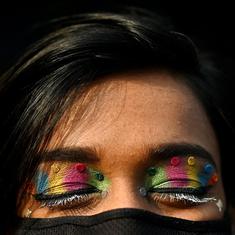Even for Kolkata’s long-term residents, the magic and frenzy of Durga Puja never ceases to excite. The air is thumping with energy – there is music and bustle, people dressed up in new outfits, bright lights on the city’s skyline and everyone determined to make the most of one week of celebrations.
For Durga Puja purists, the festival officially begins on Shoshti (the sixth day of Navratri) with the day’s prayers, or anjali. But Kolkata’s festivities begin much before – since colleges and schools break for holidays soon after Mahalaya or sometimes on the first day of the Navratri. That’s when eager “pandal-hoppers” mobilise in the hopes of catching a glimpse of their beloved Maa Durga and the city’s beautiful pandals before the crowds descend.
With Durga Puja having been included in the Unesco Representative List of the Intangible Cultural Heritage of Humanity in December 2021, there has been new vigour in this year’s celebrations. A special function was organised by the Ministry of Culture on September 24 at the Indian Museum, Kolkata, where a group of 30 artists involved in spearheading Durga Puja celebrations were honoured.

Kolkata is a city known for its plurality and secularism. These values shine brighter during Durga Puja festivities. While the rituals and prayers are Hindu, it is not uncommon to see people of other faiths visiting pandals, relishing bhog, or participating in the devotional dhunuchi naach.
Yet, in an alarming incident, the police on October 3 registered a case against West Bengal All India Hindu Mahasabha President Chandrachur Goswami after a pandal organised by his group featured a display with Mohandas Gandhi among the asuras.
Celebrations are incomplete without food and there are no restrictions on what can be eaten. Roadside eateries as well as high-end restaurants pull out all stops to offer their best to pandal-hoppers – from Kolkata’s famed biryani, kathi rolls, fish fries, phuchka, to more unexpected food items such as dosa and idli, pav bhaji and an assortment of sweets and chaat. The choices are endless.
For a long, the pujas have been broadly divided into two categories – “bari” or “rajbari poojo”, and “sarbojanin”, or public, puja. A bari or rajbari poojo is organised at the homes of former noble or zamindar families. Some of these families have been holding pujas at the same venue for many generations, sometimes for as long as two centuries. Sarbojanin pujas were started by the working class and are open to everyone. With time, sarbojanin pujas have become synonymous with the best creativity and craftsmanship of the festive season.
The idols or pandals are also categorised as “shabeki”, or traditional, puja and themed puja. Shabeki pandals are usually no frills and identifiable by their imposing structures of deities in traditional garb. These pandals resemble a well-decked up tent with bright colours and lights.
Here are a few idols and pandals of traditional pujas.




The second kind, known as themed puja, represents an idea or a theme. The artists are free to exercise their creativity – the deities could be created from a variety of raw materials, Durga may be represented as someone other than the demon-slayer Mahishasura Mardini and the deities are an extension of the larger idea that the artist wants to convey.
In such pandals, it is common to find adaptations of various art styles and an incorporation of modern life into the grandeur of the festivities. Placing the deity in a contemporary setting can give the assurance that the goddess is with everyone, watching over them as they go out about their daily lives.
Here are a few themed pandals.


































